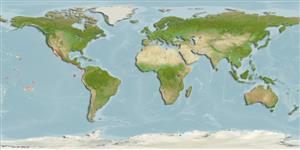Teleostei (teleosts) >
Carangiformes (Jacks) >
Carangidae (Jacks and pompanos) > Scomberoidinae
Etymology: Oligoplites: Greek, oligos = small + Greek, hoplites = armed (Ref. 45335).
More on author: Günther.
Environment: milieu / climate zone / depth range / distribution range
Ecology
Marine; brackish; benthopelagic. Tropical; 32°N -
Eastern Pacific: Mexico to Peru.
Size / Weight / Age
Maturity: Lm ? range ? - ? cm
Max length : 56.0 cm FL male/unsexed; (Ref. 40637); common length : 30.0 cm FL male/unsexed; (Ref. 9283); max. published weight: 1.6 kg (Ref. 40637)
Body elongate, fairly deep, and compressed (depth from 2.5 to 3.4 times in standard length); posterior edge of upper jaw extending beyond posterior rim of eye; upper jaw teeth small and villiform; lower branch of first gill arch with 8 to 13 gill rakers; scales small but visible, needle-shaped, embedded in the skin; body gray or brown; flanks and belly silvery with yellow highlights (Ref. 55763).
Adults inhabit coastal waters, entering estuaries (Ref. 9283). Dorsal and anal spines of this species are connected to venomous glands that may inflict painful wounds (Ref. 9283). Marketed fresh and salted or dried (Ref. 9283).
Life cycle and mating behavior
Maturity | Reproduction | Spawning | Eggs | Fecundity | Larvae
Smith-Vaniz, W.F., 1995. Carangidae. Jureles, pámpanos, cojinúas, zapateros, cocineros, casabes, macarelas, chicharros, jorobados, medregales, pez pilota. p. 940-986. In W. Fischer, F. Krupp, W. Schneider, C. Sommer, K.E. Carpenter and V. Niem (eds.) Guia FAO para Identification de Especies para lo Fines de la Pesca. Pacifico Centro-Oriental. 3 Vols. FAO, Rome. (Ref. 9283)
IUCN Red List Status (Ref. 130435: Version 2024-1)
Human uses
Fisheries: commercial
Tools
Special reports
Download XML
Internet sources
Estimates based on models
Preferred temperature (Ref.
123201): 20 - 28.4, mean 24.9 °C (based on 70 cells).
Phylogenetic diversity index (Ref.
82804): PD
50 = 0.5312 [Uniqueness, from 0.5 = low to 2.0 = high].
Bayesian length-weight: a=0.00955 (0.00605 - 0.01506), b=2.94 (2.81 - 3.07), in cm total length, based on LWR estimates for this species & Genus-body shape (Ref.
93245).
Trophic level (Ref.
69278): 4.1 ±0.0 se; based on diet studies.
Resilience (Ref.
120179): Medium, minimum population doubling time 1.4 - 4.4 years (Preliminary K or Fecundity.).
Fishing Vulnerability (Ref.
59153): Moderate vulnerability (45 of 100).
Nutrients (Ref.
124155): Calcium = 95.3 [58.5, 210.9] mg/100g; Iron = 1.01 [0.58, 2.01] mg/100g; Protein = 18.8 [17.6, 20.0] %; Omega3 = 0.253 [0.138, 0.478] g/100g; Selenium = 52 [27, 99] μg/100g; VitaminA = 23.8 [7.0, 65.1] μg/100g; Zinc = 1.17 [0.81, 1.68] mg/100g (wet weight);
